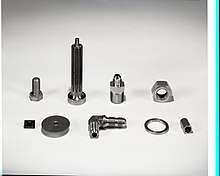Ion plating
Ion plating (IP) is a physical vapor deposition (PVD) process that is sometimes called ion assisted deposition (IAD) or ion vapor deposition (IVD) and is a version of vacuum deposition. Ion plating uses concurrent or periodic bombardment of the substrate, and deposits film by atomic-sized energetic particles. Bombardment prior to deposition is used to sputter clean the substrate surface. During deposition the bombardment is used to modify and control the properties of the depositing film. It is important that the bombardment be continuous between the cleaning and the deposition portions of the process to maintain an atomically clean interface.


Process
In ion plating the energy, flux and mass of the bombarding species along with the ratio of bombarding particles to depositing particles are important processing variables. The depositing material may be vaporized either by evaporation, sputtering (bias sputtering), arc vaporization or by decomposition of a chemical vapor precursor chemical vapor deposition (CVD). The energetic particles used for bombardment are usually ions of an inert or reactive gas, or, in some cases, ions of the condensing film material ("film ions"). Ion plating can be done in a plasma environment where ions for bombardment are extracted from the plasma or it may be done in a vacuum environment where ions for bombardment are formed in a separate ion gun. The latter ion plating configuration is often called Ion Beam Assisted Deposition (IBAD). By using a reactive gas or vapor in the plasma, films of compound materials can be deposited.
Ion plating is used to deposit hard coatings of compound materials on tools, adherent metal coatings, optical coatings with high densities, and conformal coatings on complex surfaces.
Advantages
- Better surface coverage than other methods (Physical vapor deposition, Sputter deposition).[1]
- More energy available on the surface of the bombarding species, resulting in more complete bonding.[1]
- Flexibility with the level of ion bombardment.[1]
- Improved chemical reactions when supplying plasma and energy to surface of the bombarding species.[1]
History
The ion plating process was first described in the technical literature by Donald M. Mattox of Sandia National Laboratories in 1964.[2]
Further reading
- Anders, André, ed. (3 October 2000). Handbook of Plasma Immersion Ion Implantation and Deposition (1st ed.). Wiley-VCH. doi:10.1016/S0257-8972(97)00037-6. ISBN 978-0471246985. LCCN 99089627. OCLC 634942008. OL 7614013M.
- Bach, Hans; Krause, Dieter, eds. (10 July 2003). Thin Films on Glass (Schott Series on Glass and Glass Ceramics). Schott Series on Glass and Glass Ceramics. Springer Science+Business Media. doi:10.1007/978-3-662-03475-0. ISBN 978-3540585978. LCCN 97029134. OCLC 751529805. OL 682447M. Retrieved 10 October 2019.
- Bunshah, Rointan F. (15 January 1995). Handbook of deposition technologies for films and coatings : science, technology and applications. Materials science and process technology series (2nd ed.). William Andrew. ISBN 978-0815513377. LCCN 93030751. OCLC 849876613. OL 1420629M.
- Gläser, Hans Joachim (2000). Large Area Glass Coating (1st ed.). Von Ardenne Anlagentechnik. ISBN 978-3000049538. OCLC 50316451.
- Glocker, David A; Shah, I Ismat, eds. (1 October 1995). Handbook of Thin Film Process Technology (Looseleaf ed.). IOP Publishing. doi:10.1201/9781351072786. ISBN 978-0750303118. OCLC 834296544. OL 9554916M.
- Mahan, John E. (1 February 2000). Physical Vapor Deposition of Thin Films (1st ed.). Wiley-VCH. ISBN 978-0471330011. OCLC 924737051. OL 22626840M.
- Mattox, Donald M. (19 May 2010). Handbook of Physical Vapor Deposition (PVD) Processing (2nd ed.). William Andrew. doi:10.1016/C2009-0-18800-1. ISBN 978-0815520375. OCLC 613958939. OL 25555274M.
- Mattox, Donald M. (2018). The Foundations of Vacuum Coating Technology (2nd ed.). William Andrew. doi:10.1016/C2016-0-03988-8. ISBN 978-0-12-813084-1. OCLC 249553816. OL 8048877M – via Elsevier.
- Mattox, Donald M.; Mattox, Vivivenne Harwood, eds. (6 September 2018). 50 Years of Vacuum Coating Technology and the Growth of the Society of Vacuum Coaters. Society of Vacuum Coaters (2nd ed.). William Andrew. ISBN 978-0128130841. LCCN 2003004260. OCLC 1104455795.
- Westwood, William D. (2003). Sputter deposition. AVS Education Committee book series. 2. Education Committee, AVS. ISBN 978-0735401051. OCLC 52382234. OL 10597406M.
- Willey, Ronald R. (15 December 2007). Practical Monitoring and Control of Optical Thin Films. Willey Optical Consultants (2nd ed.). Willey Optical, Consultants. ISBN 978-0615181448. OCLC 500718626.
- Willey, Ronald R. (27 October 2007). Practical Equipment, Materials, and Processes for Optical Thin Films. Willey Optical, Consultants. ISBN 978-0615143972. OCLC 954134936. OL 26817514M.
See also
- List of coating techniques
References
- Lampert, Dr. Carl (3 January 2013). "Vacuum Deposition and Coating Options". pfonline.com. Gardner Business Media. Archived from the original on 16 July 2017. Retrieved 10 October 2019.
Ion plating uses energetic ion bombardment during deposition to densify the deposit and control properties of the coating such as stress and microstructure.
- Mattox, Donald M. (1 September 1964). Sandia National Laboratories. "Film Deposition Using Accelerated Ions". Electrochemical Technology. 2. OCLC 571781676. OSTI 4672659.